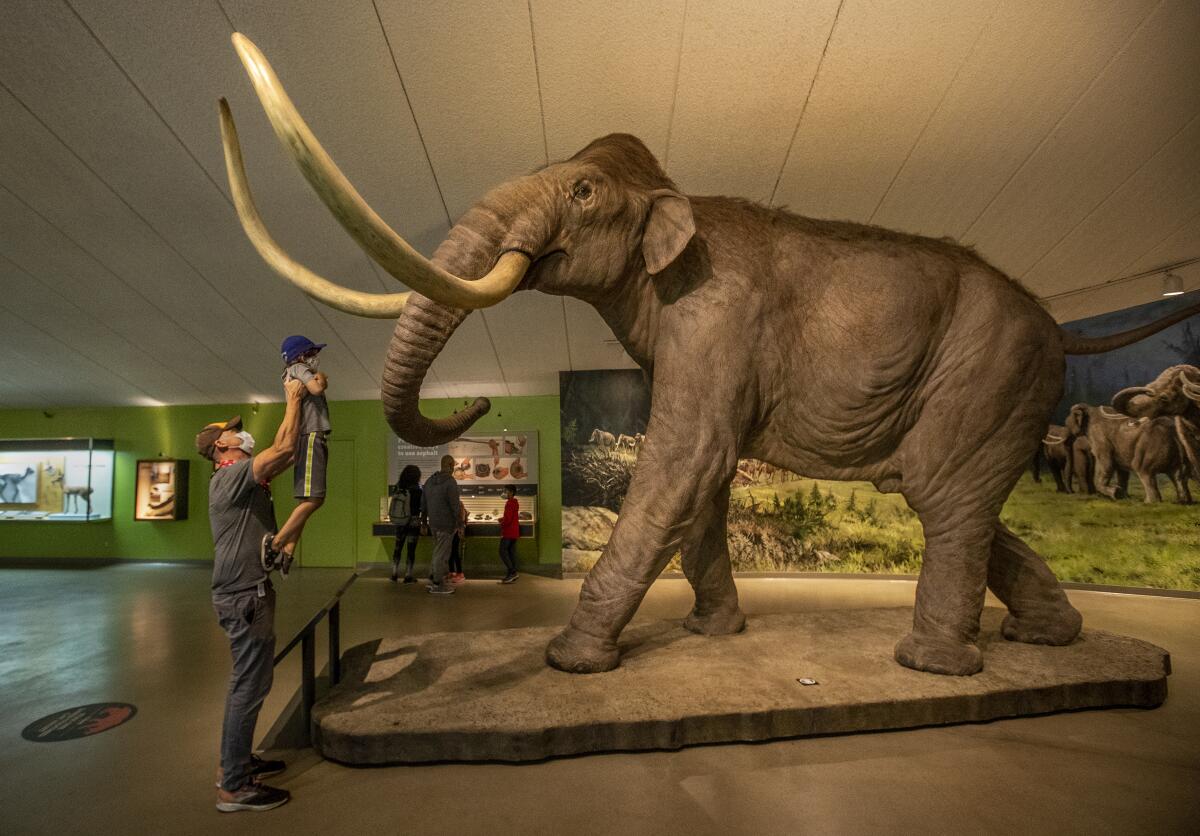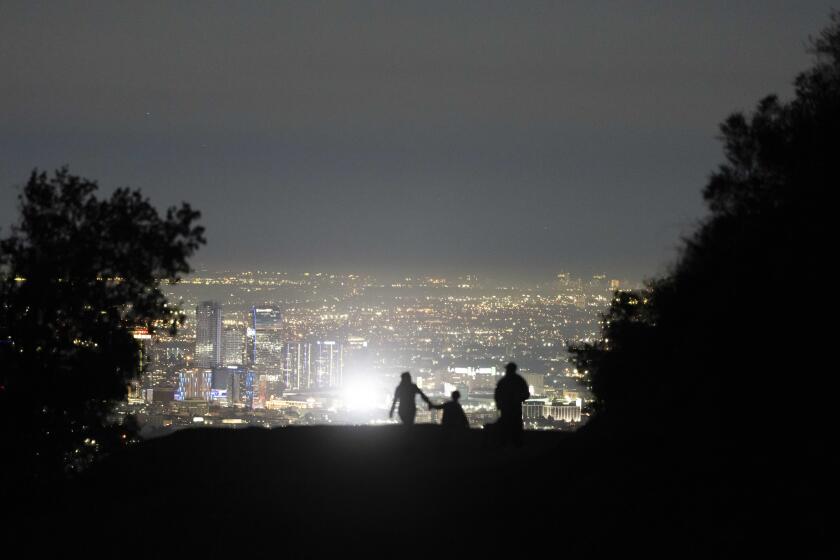Yes, there was global warming in prehistoric times. But nothing in millions of years compares with what we see today

- Share via
“The climate is always changing!” So goes a popular refrain from climate deniers who continue to claim that there’s nothing special about this particular moment. There is no climate crisis, they say, because the Earth has survived dramatic warming before.
Republican presidential hopeful Vivek Ramaswamy recently exemplified misconceptions about our planet’s climate past. When he asserted that “carbon dioxide as a percentage of the atmosphere is still at a relative low through human history,” he didn’t just make a false statement (carbon dioxide concentrations are the highest they’ve been in at least 4 million years). He also showed fundamentally wrong thinking around the climate crisis.
Levels of heat-trapping carbon dioxide in Earth’s atmosphere increased to record highs in its spring peak, yet another sign that global warming isn’t slowing down.
What threatens us today isn’t the particular concentration of carbon dioxide in the atmosphere or the precise temperature of the planet, alarming as those two metrics are. Instead, it’s the unprecedented rate at which we are increasing carbon pollution through fossil fuel burning, and the resulting rate at which we are heating the planet.
Consider the warming event that paleoclimatologists point to as the best natural comparison for the rapid greenhouse-driven trend we’re seeing now. The Paleocene-Eocene Thermal Maximum happened 56 million years ago, roughly 10 million years after the demise of the dinosaurs, which itself was caused by climate change (a massive asteroid impact event led to a global dust storm and, in turn, rapid cooling). The PETM warming resulted from an unusually large and rapid injection of carbon dioxide into the atmosphere from volcanic eruptions in Iceland. Global temperatures increased by approximately 10 degrees Fahrenheit in as little as 10,000 years, rising from an already steamy baseline of 80 degrees Fahrenheit possibly up to a sauna-like 90 degrees Fahrenheit.
That warming rate of about 0.1 degree Fahrenheit per century is extremely rapid by geological standards. But it’s still roughly 10 times slower than the warming today.
Some people say the best way to battle climate change is with optimism. Here’s why that won’t work.
The impact event and Paleocene-Eocene Thermal Maximum were, ironically, fortuitous for humans: They paved the way for our ancestors. The extinction of the dinosaurs (except the ancestors of birds) created a new niche for early mammals, and the stifling conditions of the Paleocene-Eocene Thermal Maximum selected for small, arboreal mammals, including the oldest primate identified clearly by fossil materials, a primitive lemur-like creature named Dryomomys. Without either of these two events, our species likely wouldn’t have arrived at this moment — in contrast to the current warming, which plenty of evidence shows is a threat to our existence.
Extinctions followed another warming period in our more recent past, when the last ice age ended about 18,000 years ago. Driven by Earth’s changing orbit relative to the sun, and boosted by a heightened greenhouse effect as warming oceans gave up their carbon dioxide in the same way an open bottle of warm soda loses carbonation, the planet warmed by about 10 degrees Fahrenheit over the subsequent 8,000 years.
That rate of warming — which, again, was about 10 times slower than the warming today — was rapid enough to wipe out entire species. Gone were the magnificent woolly mammoths and mastodons, giant ground sloths and saber-toothed cats that had roamed the plains of North America. A combination of climate change and overhunting by paleo-Americans did them in. A few of them got stuck in tar pits and are preserved — some at the La Brea Tar Pits in Los Angeles.
For California to successfully fight climate change, the state’s politicians, business leaders and millions of residents will need to work a lot harder.
In the fall of 2017, I participated in a climate change forum at the tar pits museum, which is at the center of those ancient pools of asphalt — the viscous, evaporated remains of crude oil that seeped to the surface from deep below. I couldn’t help but see further irony there: Crude oil from beneath Earth’s surface threatens us today because we’re ensnared by it politically rather than physically.
Paleo-humans survived the end of the ice age because of the resilience afforded by our big brains, which gave us the behavioral plasticity to adapt to the changing climate. But that same intelligence has gotten us into trouble today. We’ve used it to create a global energy system dependent on the burning of fossil fuels. The great Carl Sagan once commented on the absurdity of our plight: “Our civilization runs by burning the remains of humble creatures who inhabited the Earth hundreds of millions of years before the first humans came on the scene. Like some ghastly cannibal cult, we subsist on the dead bodies of our ancestors and distant relatives.”
Our societal infrastructure — upon which more than 8 billion people now depend — was built around a global climate that was stable for thousands of years. The viability of that infrastructure depends on the climate remaining close to what it was, or at least changing slowly enough that the rates of environmental change don’t exceed our adaptive capacity as a species and a civilization. What finished off the dinosaurs and the mastodons was a climate that shifted too rapidly away from what they were adapted to, in the first case cooling and the other case warming. That’s our challenge today.
We can apply lessons from tackling another existential problem to the climate crisis.
Can our big brains save us this time? They can if we make proper use of them and learn the lessons offered by Earth’s past. Paleoclimate data characterizing past episodes of natural climate change, such as the Paleocene-Eocene Thermal Maximum and peak of the last ice age, allow us to test the models that we use to project future warming. Our models pass these tests, reproducing the paleodata from historical periods when driven by the estimated changes in greenhouse gases and sunlight during those periods. The paleodata, in turn, help us refine the models.
The end result is that we can trust these models to peer into our climate future. They tell us that we can avoid a catastrophic trajectory for our global climate if we reduce carbon emissions substantially over the next decade. So this fragile moment in which we find ourselves is in fact a critical juncture.
As Sagan said: “We are at a crossroads in human history. Never before has there been a moment so simultaneously perilous and promising.” The choice between peril and promise is ultimately still ours.
Michael E. Mann is presidential distinguished professor and director of the Center for Science, Sustainability and the Media at the University of Pennsylvania. He is the author of the forthcoming book “Our Fragile Moment: How Lessons from Earth’s Past Can Help Us Survive the Climate Crisis.”
More to Read
A cure for the common opinion
Get thought-provoking perspectives with our weekly newsletter.
You may occasionally receive promotional content from the Los Angeles Times.













